NUR250 Assessment 1 S1 2018: Patient Assessment and Care Planning
VerifiedAdded on 2024/05/21
|17
|3396
|265
Report
AI Summary
This report provides a detailed patient assessment and care plan for Jim, a 58-year-old homeless male presenting with influenza symptoms. Task 1 focuses on the initial assessment, covering airway, breathing, and body temperature, emphasizing the importance of regular monitoring for effective care. Task 2 presents a nursing care plan addressing key problems like the risk of infection spread, self-care deficit, fluid volume imbalance, acute pain, and hyperthermia, outlining specific nursing interventions and rationales. Task 3 discusses medication management, including the administration of oseltamivir, paracetamol, and the flu vaccine (Fluvax), highlighting the nurse's role in patient education, proper administration, and monitoring for adverse reactions. This assignment highlights the crucial aspects of nursing care in managing a vulnerable patient's health needs.
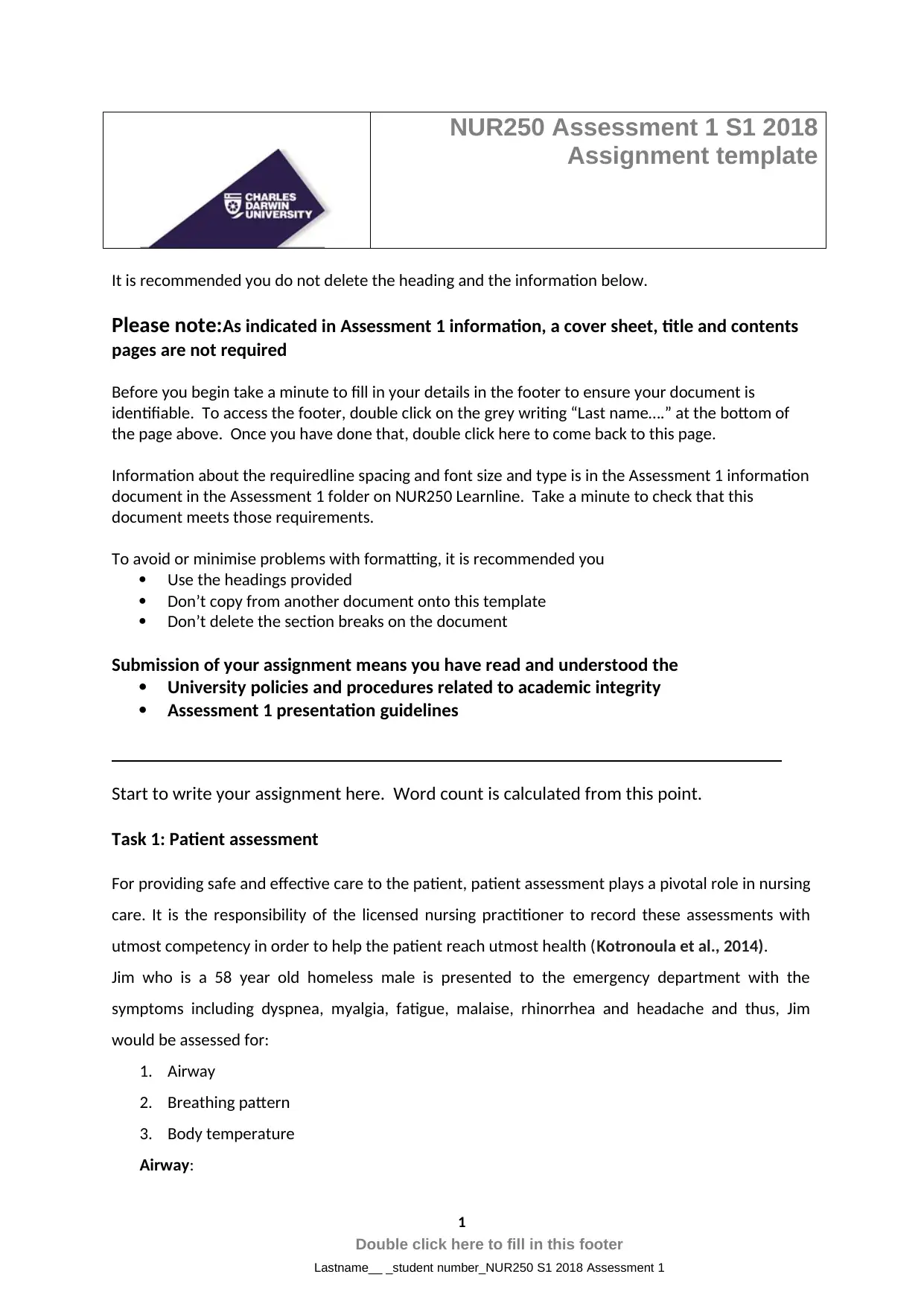
NUR250 Assessment 1 S1 2018
Assignment template
It is recommended you do not delete the heading and the information below.
Please note:As indicated in Assessment 1 information, a cover sheet, title and contents
pages are not required
Before you begin take a minute to fill in your details in the footer to ensure your document is
identifiable. To access the footer, double click on the grey writing “Last name….” at the bottom of
the page above. Once you have done that, double click here to come back to this page.
Information about the requiredline spacing and font size and type is in the Assessment 1 information
document in the Assessment 1 folder on NUR250 Learnline. Take a minute to check that this
document meets those requirements.
To avoid or minimise problems with formatting, it is recommended you
Use the headings provided
Don’t copy from another document onto this template
Don’t delete the section breaks on the document
Submission of your assignment means you have read and understood the
University policies and procedures related to academic integrity
Assessment 1 presentation guidelines
Start to write your assignment here. Word count is calculated from this point.
Task 1: Patient assessment
For providing safe and effective care to the patient, patient assessment plays a pivotal role in nursing
care. It is the responsibility of the licensed nursing practitioner to record these assessments with
utmost competency in order to help the patient reach utmost health (Kotronoula et al., 2014).
Jim who is a 58 year old homeless male is presented to the emergency department with the
symptoms including dyspnea, myalgia, fatigue, malaise, rhinorrhea and headache and thus, Jim
would be assessed for:
1. Airway
2. Breathing pattern
3. Body temperature
Airway:
1
Double click here to fill in this footer
Lastname__ _student number_NUR250 S1 2018 Assessment 1
Assignment template
It is recommended you do not delete the heading and the information below.
Please note:As indicated in Assessment 1 information, a cover sheet, title and contents
pages are not required
Before you begin take a minute to fill in your details in the footer to ensure your document is
identifiable. To access the footer, double click on the grey writing “Last name….” at the bottom of
the page above. Once you have done that, double click here to come back to this page.
Information about the requiredline spacing and font size and type is in the Assessment 1 information
document in the Assessment 1 folder on NUR250 Learnline. Take a minute to check that this
document meets those requirements.
To avoid or minimise problems with formatting, it is recommended you
Use the headings provided
Don’t copy from another document onto this template
Don’t delete the section breaks on the document
Submission of your assignment means you have read and understood the
University policies and procedures related to academic integrity
Assessment 1 presentation guidelines
Start to write your assignment here. Word count is calculated from this point.
Task 1: Patient assessment
For providing safe and effective care to the patient, patient assessment plays a pivotal role in nursing
care. It is the responsibility of the licensed nursing practitioner to record these assessments with
utmost competency in order to help the patient reach utmost health (Kotronoula et al., 2014).
Jim who is a 58 year old homeless male is presented to the emergency department with the
symptoms including dyspnea, myalgia, fatigue, malaise, rhinorrhea and headache and thus, Jim
would be assessed for:
1. Airway
2. Breathing pattern
3. Body temperature
Airway:
1
Double click here to fill in this footer
Lastname__ _student number_NUR250 S1 2018 Assessment 1
Paraphrase This Document
Need a fresh take? Get an instant paraphrase of this document with our AI Paraphraser
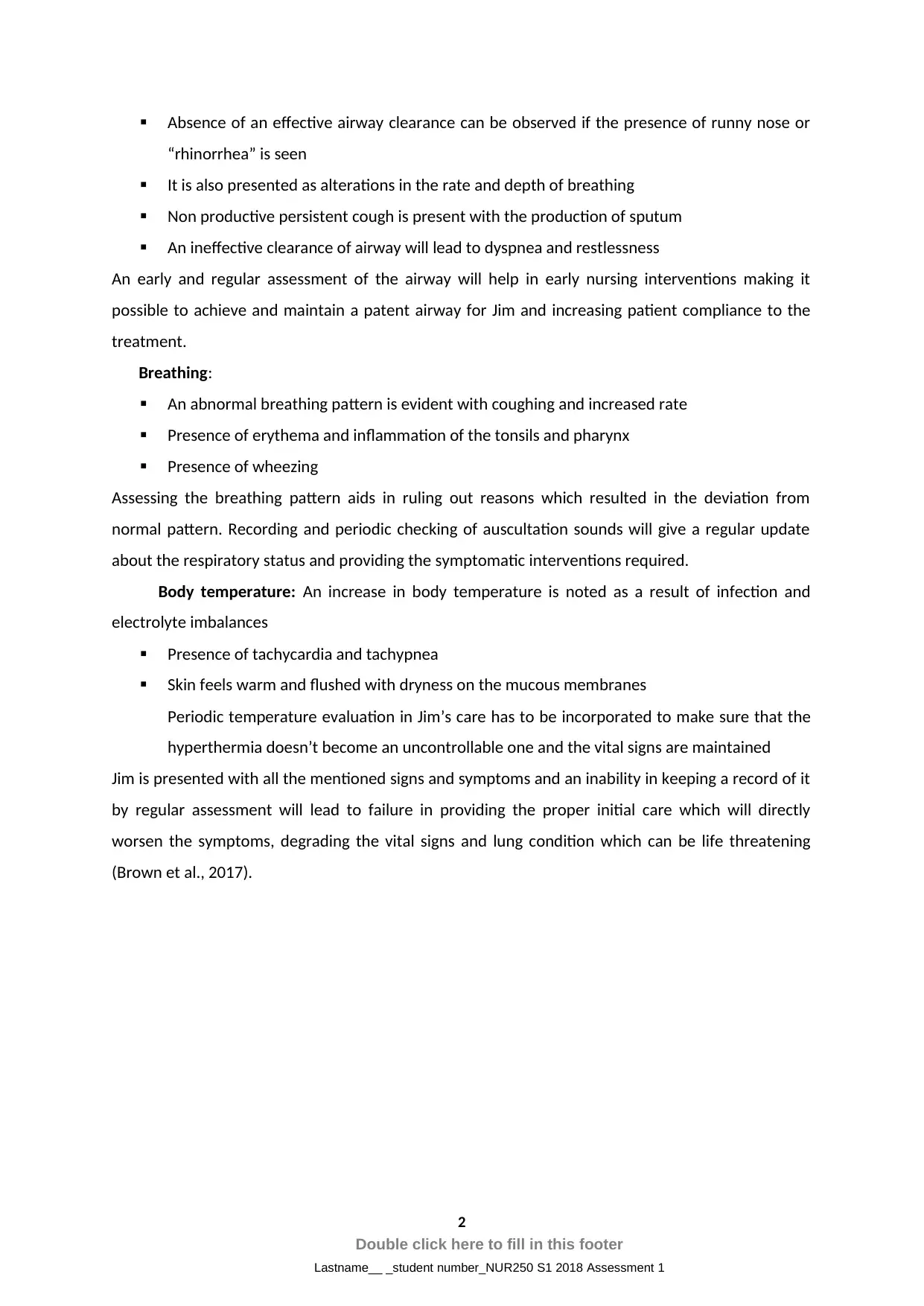
Absence of an effective airway clearance can be observed if the presence of runny nose or
“rhinorrhea” is seen
It is also presented as alterations in the rate and depth of breathing
Non productive persistent cough is present with the production of sputum
An ineffective clearance of airway will lead to dyspnea and restlessness
An early and regular assessment of the airway will help in early nursing interventions making it
possible to achieve and maintain a patent airway for Jim and increasing patient compliance to the
treatment.
Breathing:
An abnormal breathing pattern is evident with coughing and increased rate
Presence of erythema and inflammation of the tonsils and pharynx
Presence of wheezing
Assessing the breathing pattern aids in ruling out reasons which resulted in the deviation from
normal pattern. Recording and periodic checking of auscultation sounds will give a regular update
about the respiratory status and providing the symptomatic interventions required.
Body temperature: An increase in body temperature is noted as a result of infection and
electrolyte imbalances
Presence of tachycardia and tachypnea
Skin feels warm and flushed with dryness on the mucous membranes
Periodic temperature evaluation in Jim’s care has to be incorporated to make sure that the
hyperthermia doesn’t become an uncontrollable one and the vital signs are maintained
Jim is presented with all the mentioned signs and symptoms and an inability in keeping a record of it
by regular assessment will lead to failure in providing the proper initial care which will directly
worsen the symptoms, degrading the vital signs and lung condition which can be life threatening
(Brown et al., 2017).
2
Double click here to fill in this footer
Lastname__ _student number_NUR250 S1 2018 Assessment 1
“rhinorrhea” is seen
It is also presented as alterations in the rate and depth of breathing
Non productive persistent cough is present with the production of sputum
An ineffective clearance of airway will lead to dyspnea and restlessness
An early and regular assessment of the airway will help in early nursing interventions making it
possible to achieve and maintain a patent airway for Jim and increasing patient compliance to the
treatment.
Breathing:
An abnormal breathing pattern is evident with coughing and increased rate
Presence of erythema and inflammation of the tonsils and pharynx
Presence of wheezing
Assessing the breathing pattern aids in ruling out reasons which resulted in the deviation from
normal pattern. Recording and periodic checking of auscultation sounds will give a regular update
about the respiratory status and providing the symptomatic interventions required.
Body temperature: An increase in body temperature is noted as a result of infection and
electrolyte imbalances
Presence of tachycardia and tachypnea
Skin feels warm and flushed with dryness on the mucous membranes
Periodic temperature evaluation in Jim’s care has to be incorporated to make sure that the
hyperthermia doesn’t become an uncontrollable one and the vital signs are maintained
Jim is presented with all the mentioned signs and symptoms and an inability in keeping a record of it
by regular assessment will lead to failure in providing the proper initial care which will directly
worsen the symptoms, degrading the vital signs and lung condition which can be life threatening
(Brown et al., 2017).
2
Double click here to fill in this footer
Lastname__ _student number_NUR250 S1 2018 Assessment 1

3
Double click here to fill in this footer
Lastname__ _student number_NUR250 S1 2018 Assessment 1
Double click here to fill in this footer
Lastname__ _student number_NUR250 S1 2018 Assessment 1
⊘ This is a preview!⊘
Do you want full access?
Subscribe today to unlock all pages.

Trusted by 1+ million students worldwide
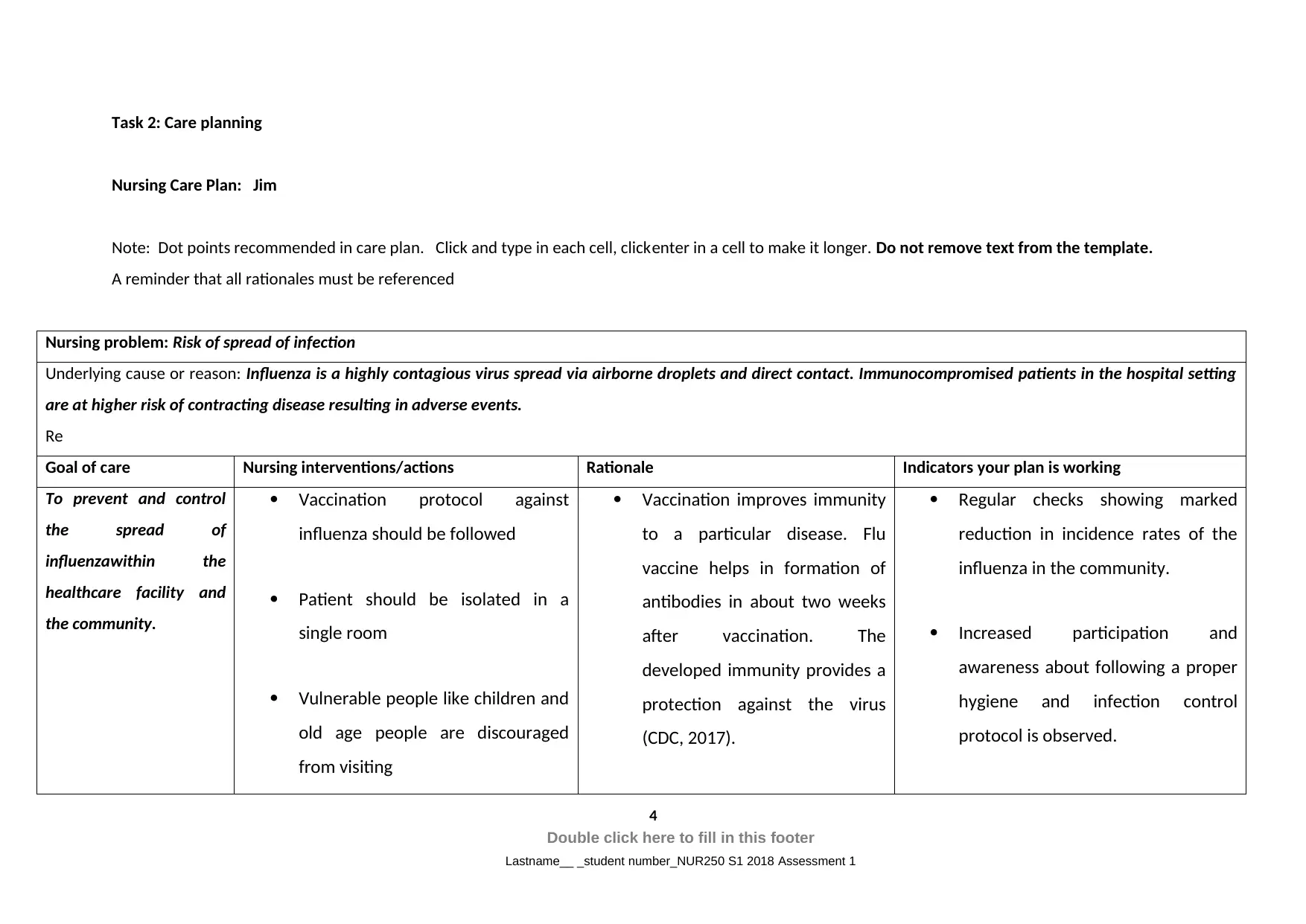
Task 2: Care planning
Nursing Care Plan: Jim
Note: Dot points recommended in care plan. Click and type in each cell, clickenter in a cell to make it longer. Do not remove text from the template.
A reminder that all rationales must be referenced
Nursing problem: Risk of spread of infection
Underlying cause or reason: Influenza is a highly contagious virus spread via airborne droplets and direct contact. Immunocompromised patients in the hospital setting
are at higher risk of contracting disease resulting in adverse events.
Re
Goal of care Nursing interventions/actions Rationale Indicators your plan is working
To prevent and control
the spread of
influenzawithin the
healthcare facility and
the community.
Vaccination protocol against
influenza should be followed
Patient should be isolated in a
single room
Vulnerable people like children and
old age people are discouraged
from visiting
Vaccination improves immunity
to a particular disease. Flu
vaccine helps in formation of
antibodies in about two weeks
after vaccination. The
developed immunity provides a
protection against the virus
(CDC, 2017).
Regular checks showing marked
reduction in incidence rates of the
influenza in the community.
Increased participation and
awareness about following a proper
hygiene and infection control
protocol is observed.
4
Double click here to fill in this footer
Lastname__ _student number_NUR250 S1 2018 Assessment 1
Nursing Care Plan: Jim
Note: Dot points recommended in care plan. Click and type in each cell, clickenter in a cell to make it longer. Do not remove text from the template.
A reminder that all rationales must be referenced
Nursing problem: Risk of spread of infection
Underlying cause or reason: Influenza is a highly contagious virus spread via airborne droplets and direct contact. Immunocompromised patients in the hospital setting
are at higher risk of contracting disease resulting in adverse events.
Re
Goal of care Nursing interventions/actions Rationale Indicators your plan is working
To prevent and control
the spread of
influenzawithin the
healthcare facility and
the community.
Vaccination protocol against
influenza should be followed
Patient should be isolated in a
single room
Vulnerable people like children and
old age people are discouraged
from visiting
Vaccination improves immunity
to a particular disease. Flu
vaccine helps in formation of
antibodies in about two weeks
after vaccination. The
developed immunity provides a
protection against the virus
(CDC, 2017).
Regular checks showing marked
reduction in incidence rates of the
influenza in the community.
Increased participation and
awareness about following a proper
hygiene and infection control
protocol is observed.
4
Double click here to fill in this footer
Lastname__ _student number_NUR250 S1 2018 Assessment 1
Paraphrase This Document
Need a fresh take? Get an instant paraphrase of this document with our AI Paraphraser
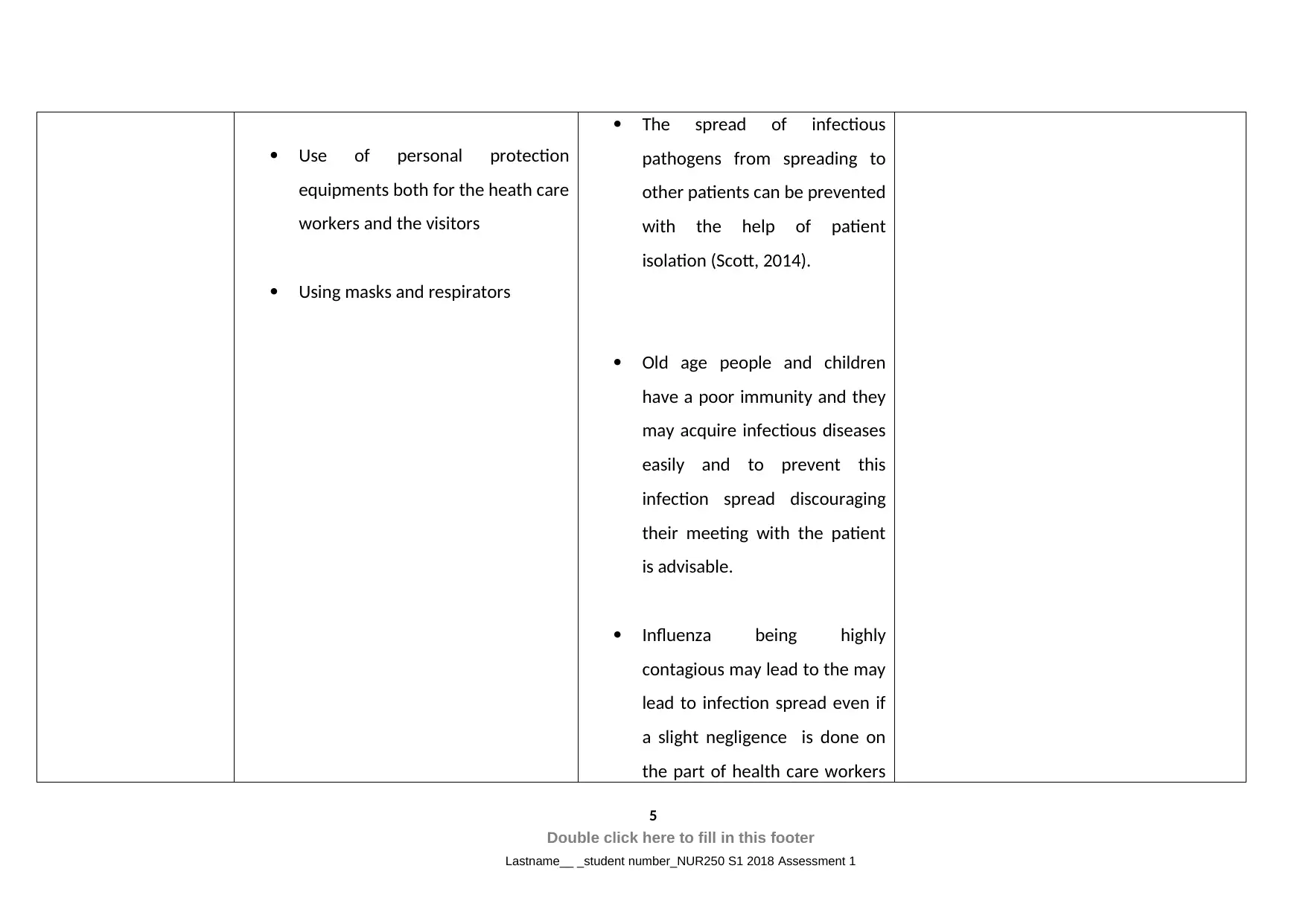
Use of personal protection
equipments both for the heath care
workers and the visitors
Using masks and respirators
The spread of infectious
pathogens from spreading to
other patients can be prevented
with the help of patient
isolation (Scott, 2014).
Old age people and children
have a poor immunity and they
may acquire infectious diseases
easily and to prevent this
infection spread discouraging
their meeting with the patient
is advisable.
Influenza being highly
contagious may lead to the may
lead to infection spread even if
a slight negligence is done on
the part of health care workers
5
Double click here to fill in this footer
Lastname__ _student number_NUR250 S1 2018 Assessment 1
equipments both for the heath care
workers and the visitors
Using masks and respirators
The spread of infectious
pathogens from spreading to
other patients can be prevented
with the help of patient
isolation (Scott, 2014).
Old age people and children
have a poor immunity and they
may acquire infectious diseases
easily and to prevent this
infection spread discouraging
their meeting with the patient
is advisable.
Influenza being highly
contagious may lead to the may
lead to infection spread even if
a slight negligence is done on
the part of health care workers
5
Double click here to fill in this footer
Lastname__ _student number_NUR250 S1 2018 Assessment 1
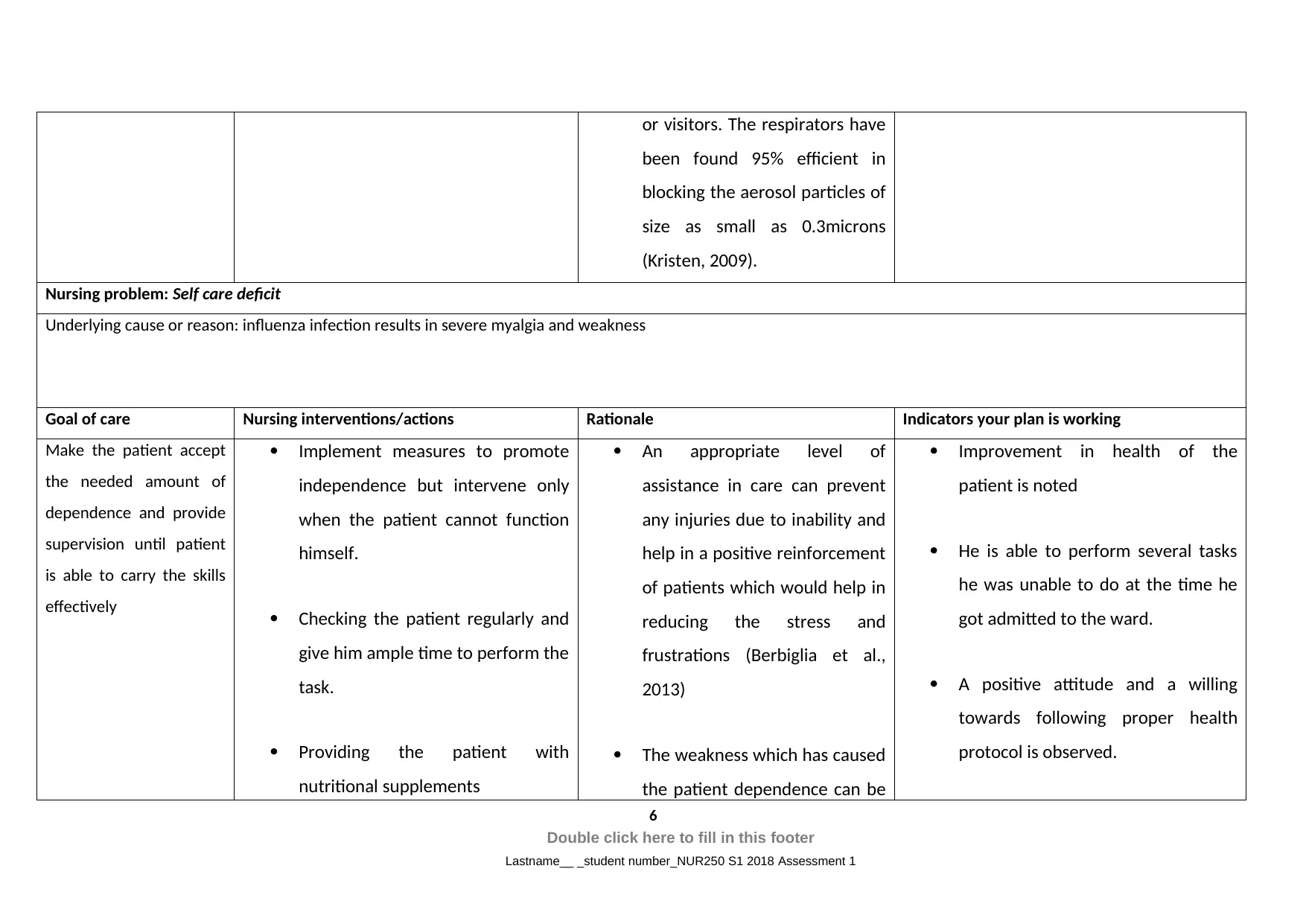
or visitors. The respirators have
been found 95% efficient in
blocking the aerosol particles of
size as small as 0.3microns
(Kristen, 2009).
Nursing problem: Self care deficit
Underlying cause or reason: influenza infection results in severe myalgia and weakness
Goal of care Nursing interventions/actions Rationale Indicators your plan is working
Make the patient accept
the needed amount of
dependence and provide
supervision until patient
is able to carry the skills
effectively
Implement measures to promote
independence but intervene only
when the patient cannot function
himself.
Checking the patient regularly and
give him ample time to perform the
task.
Providing the patient with
nutritional supplements
An appropriate level of
assistance in care can prevent
any injuries due to inability and
help in a positive reinforcement
of patients which would help in
reducing the stress and
frustrations (Berbiglia et al.,
2013)
The weakness which has caused
the patient dependence can be
Improvement in health of the
patient is noted
He is able to perform several tasks
he was unable to do at the time he
got admitted to the ward.
A positive attitude and a willing
towards following proper health
protocol is observed.
6
Double click here to fill in this footer
Lastname__ _student number_NUR250 S1 2018 Assessment 1
been found 95% efficient in
blocking the aerosol particles of
size as small as 0.3microns
(Kristen, 2009).
Nursing problem: Self care deficit
Underlying cause or reason: influenza infection results in severe myalgia and weakness
Goal of care Nursing interventions/actions Rationale Indicators your plan is working
Make the patient accept
the needed amount of
dependence and provide
supervision until patient
is able to carry the skills
effectively
Implement measures to promote
independence but intervene only
when the patient cannot function
himself.
Checking the patient regularly and
give him ample time to perform the
task.
Providing the patient with
nutritional supplements
An appropriate level of
assistance in care can prevent
any injuries due to inability and
help in a positive reinforcement
of patients which would help in
reducing the stress and
frustrations (Berbiglia et al.,
2013)
The weakness which has caused
the patient dependence can be
Improvement in health of the
patient is noted
He is able to perform several tasks
he was unable to do at the time he
got admitted to the ward.
A positive attitude and a willing
towards following proper health
protocol is observed.
6
Double click here to fill in this footer
Lastname__ _student number_NUR250 S1 2018 Assessment 1
⊘ This is a preview!⊘
Do you want full access?
Subscribe today to unlock all pages.

Trusted by 1+ million students worldwide
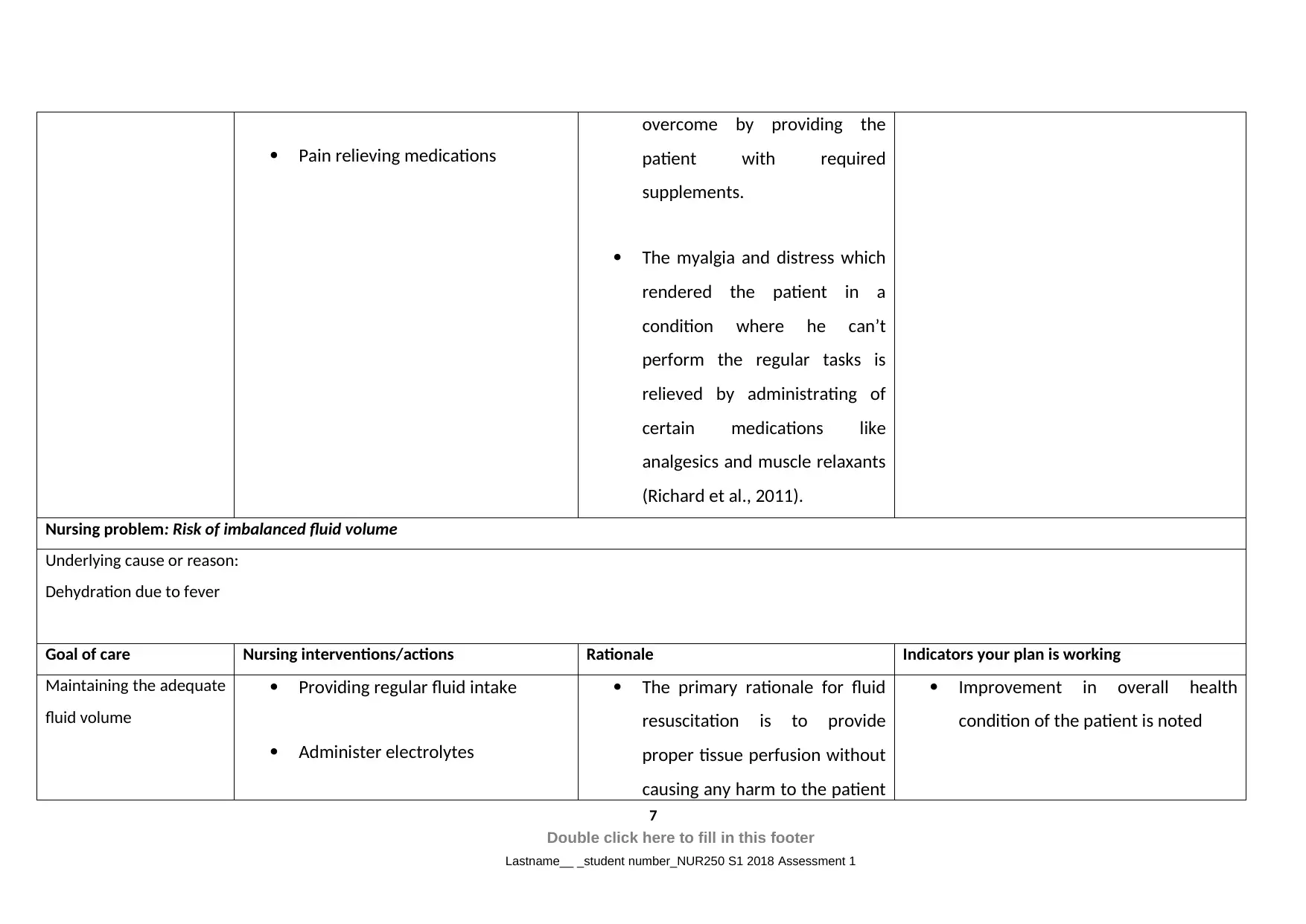
Pain relieving medications
overcome by providing the
patient with required
supplements.
The myalgia and distress which
rendered the patient in a
condition where he can’t
perform the regular tasks is
relieved by administrating of
certain medications like
analgesics and muscle relaxants
(Richard et al., 2011).
Nursing problem: Risk of imbalanced fluid volume
Underlying cause or reason:
Dehydration due to fever
Goal of care Nursing interventions/actions Rationale Indicators your plan is working
Maintaining the adequate
fluid volume
Providing regular fluid intake
Administer electrolytes
The primary rationale for fluid
resuscitation is to provide
proper tissue perfusion without
causing any harm to the patient
Improvement in overall health
condition of the patient is noted
7
Double click here to fill in this footer
Lastname__ _student number_NUR250 S1 2018 Assessment 1
overcome by providing the
patient with required
supplements.
The myalgia and distress which
rendered the patient in a
condition where he can’t
perform the regular tasks is
relieved by administrating of
certain medications like
analgesics and muscle relaxants
(Richard et al., 2011).
Nursing problem: Risk of imbalanced fluid volume
Underlying cause or reason:
Dehydration due to fever
Goal of care Nursing interventions/actions Rationale Indicators your plan is working
Maintaining the adequate
fluid volume
Providing regular fluid intake
Administer electrolytes
The primary rationale for fluid
resuscitation is to provide
proper tissue perfusion without
causing any harm to the patient
Improvement in overall health
condition of the patient is noted
7
Double click here to fill in this footer
Lastname__ _student number_NUR250 S1 2018 Assessment 1
Paraphrase This Document
Need a fresh take? Get an instant paraphrase of this document with our AI Paraphraser
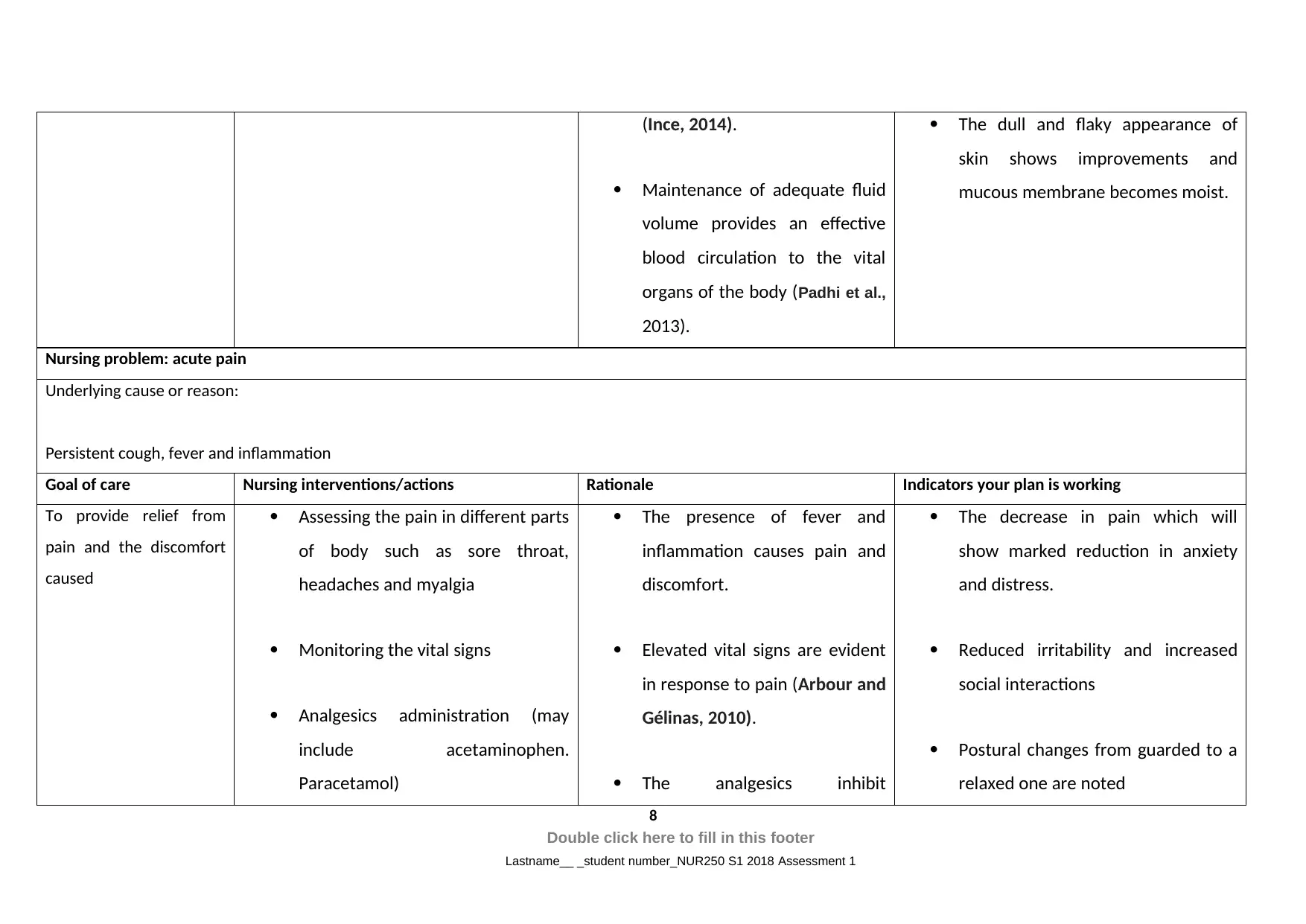
(Ince, 2014).
Maintenance of adequate fluid
volume provides an effective
blood circulation to the vital
organs of the body (Padhi et al.,
2013).
The dull and flaky appearance of
skin shows improvements and
mucous membrane becomes moist.
Nursing problem: acute pain
Underlying cause or reason:
Persistent cough, fever and inflammation
Goal of care Nursing interventions/actions Rationale Indicators your plan is working
To provide relief from
pain and the discomfort
caused
Assessing the pain in different parts
of body such as sore throat,
headaches and myalgia
Monitoring the vital signs
Analgesics administration (may
include acetaminophen.
Paracetamol)
The presence of fever and
inflammation causes pain and
discomfort.
Elevated vital signs are evident
in response to pain (Arbour and
Gélinas, 2010).
The analgesics inhibit
The decrease in pain which will
show marked reduction in anxiety
and distress.
Reduced irritability and increased
social interactions
Postural changes from guarded to a
relaxed one are noted
8
Double click here to fill in this footer
Lastname__ _student number_NUR250 S1 2018 Assessment 1
Maintenance of adequate fluid
volume provides an effective
blood circulation to the vital
organs of the body (Padhi et al.,
2013).
The dull and flaky appearance of
skin shows improvements and
mucous membrane becomes moist.
Nursing problem: acute pain
Underlying cause or reason:
Persistent cough, fever and inflammation
Goal of care Nursing interventions/actions Rationale Indicators your plan is working
To provide relief from
pain and the discomfort
caused
Assessing the pain in different parts
of body such as sore throat,
headaches and myalgia
Monitoring the vital signs
Analgesics administration (may
include acetaminophen.
Paracetamol)
The presence of fever and
inflammation causes pain and
discomfort.
Elevated vital signs are evident
in response to pain (Arbour and
Gélinas, 2010).
The analgesics inhibit
The decrease in pain which will
show marked reduction in anxiety
and distress.
Reduced irritability and increased
social interactions
Postural changes from guarded to a
relaxed one are noted
8
Double click here to fill in this footer
Lastname__ _student number_NUR250 S1 2018 Assessment 1
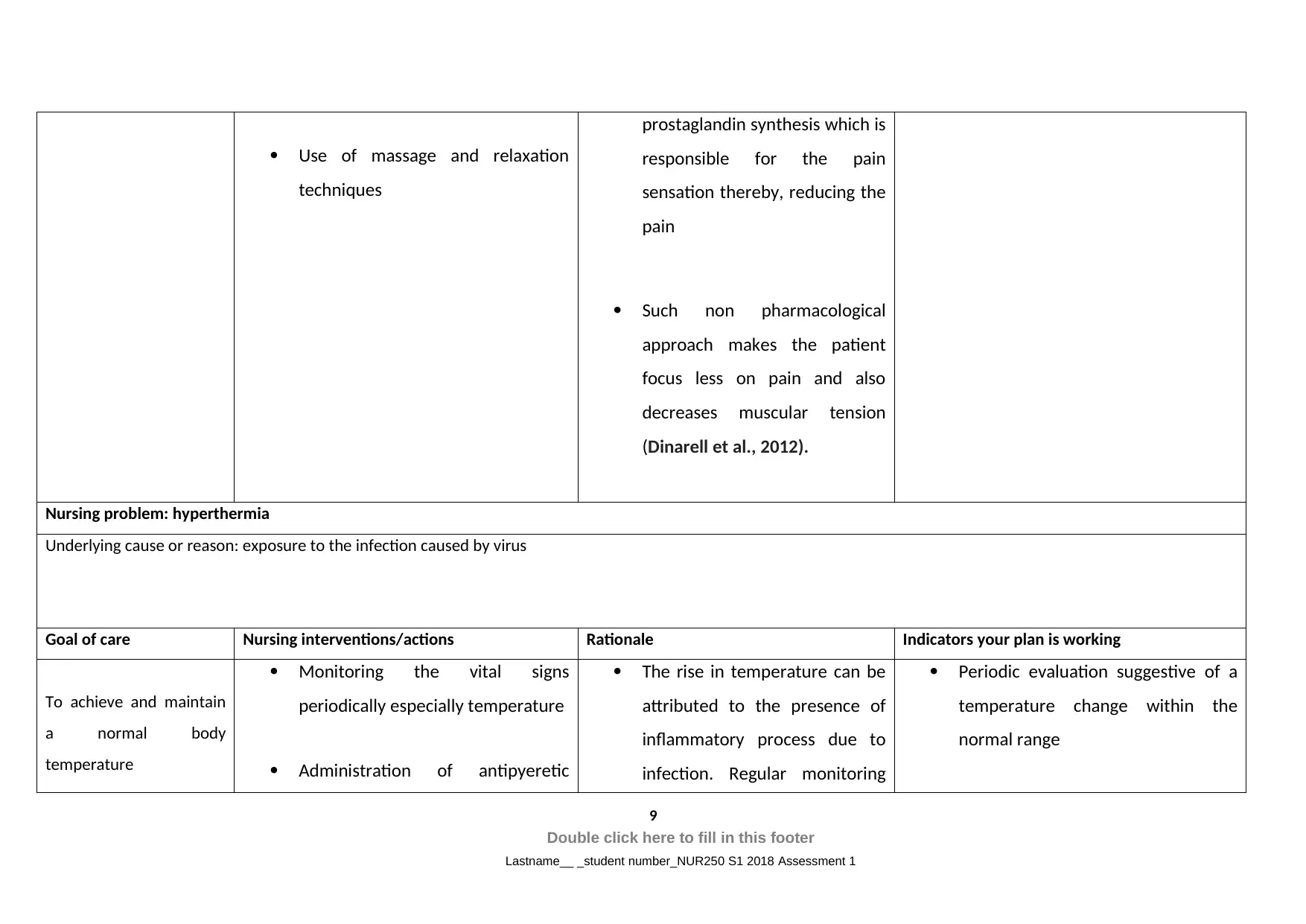
Use of massage and relaxation
techniques
prostaglandin synthesis which is
responsible for the pain
sensation thereby, reducing the
pain
Such non pharmacological
approach makes the patient
focus less on pain and also
decreases muscular tension
(Dinarell et al., 2012).
Nursing problem: hyperthermia
Underlying cause or reason: exposure to the infection caused by virus
Goal of care Nursing interventions/actions Rationale Indicators your plan is working
To achieve and maintain
a normal body
temperature
Monitoring the vital signs
periodically especially temperature
Administration of antipyeretic
The rise in temperature can be
attributed to the presence of
inflammatory process due to
infection. Regular monitoring
Periodic evaluation suggestive of a
temperature change within the
normal range
9
Double click here to fill in this footer
Lastname__ _student number_NUR250 S1 2018 Assessment 1
techniques
prostaglandin synthesis which is
responsible for the pain
sensation thereby, reducing the
pain
Such non pharmacological
approach makes the patient
focus less on pain and also
decreases muscular tension
(Dinarell et al., 2012).
Nursing problem: hyperthermia
Underlying cause or reason: exposure to the infection caused by virus
Goal of care Nursing interventions/actions Rationale Indicators your plan is working
To achieve and maintain
a normal body
temperature
Monitoring the vital signs
periodically especially temperature
Administration of antipyeretic
The rise in temperature can be
attributed to the presence of
inflammatory process due to
infection. Regular monitoring
Periodic evaluation suggestive of a
temperature change within the
normal range
9
Double click here to fill in this footer
Lastname__ _student number_NUR250 S1 2018 Assessment 1
⊘ This is a preview!⊘
Do you want full access?
Subscribe today to unlock all pages.

Trusted by 1+ million students worldwide
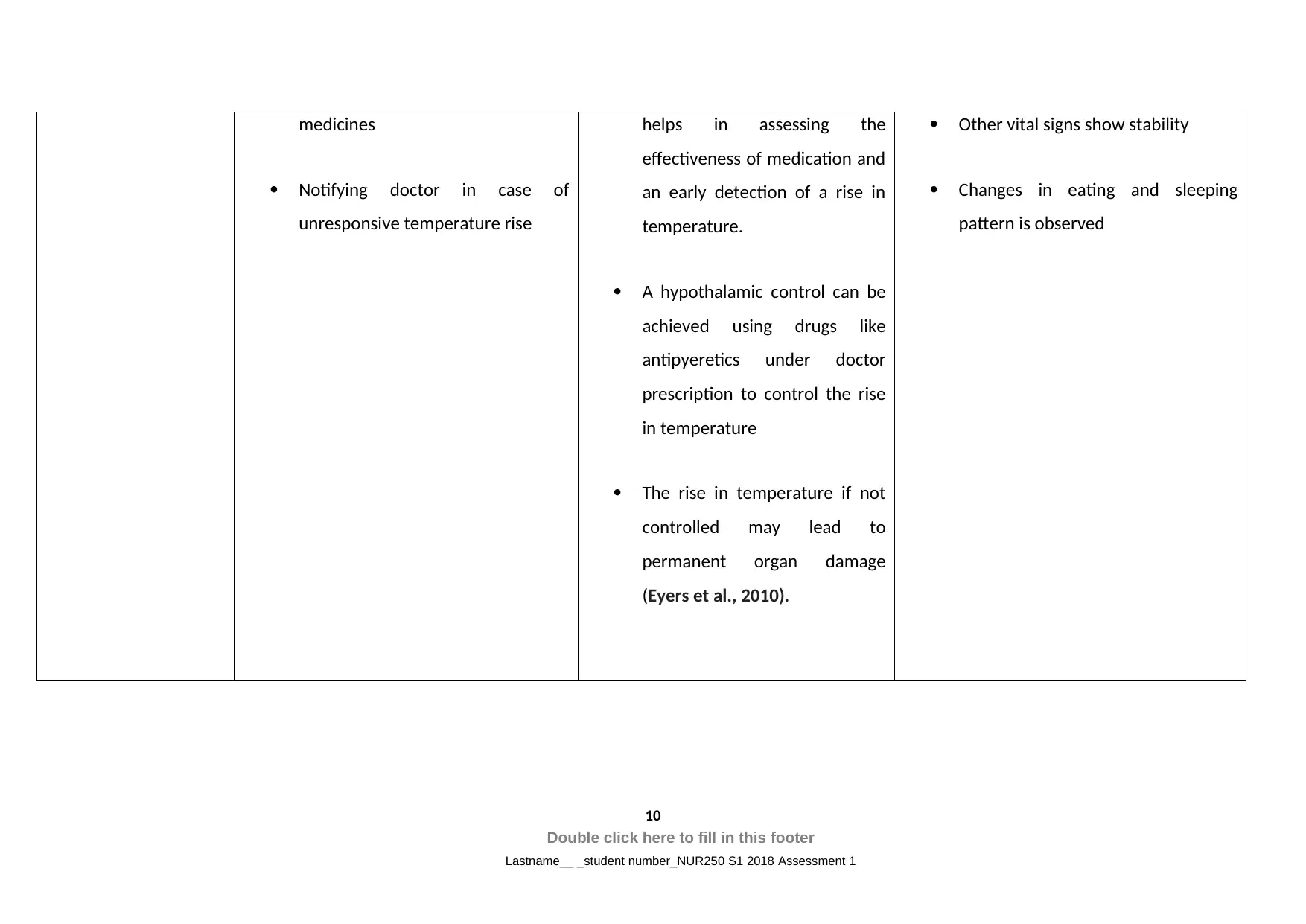
medicines
Notifying doctor in case of
unresponsive temperature rise
helps in assessing the
effectiveness of medication and
an early detection of a rise in
temperature.
A hypothalamic control can be
achieved using drugs like
antipyeretics under doctor
prescription to control the rise
in temperature
The rise in temperature if not
controlled may lead to
permanent organ damage
(Eyers et al., 2010).
Other vital signs show stability
Changes in eating and sleeping
pattern is observed
10
Double click here to fill in this footer
Lastname__ _student number_NUR250 S1 2018 Assessment 1
Notifying doctor in case of
unresponsive temperature rise
helps in assessing the
effectiveness of medication and
an early detection of a rise in
temperature.
A hypothalamic control can be
achieved using drugs like
antipyeretics under doctor
prescription to control the rise
in temperature
The rise in temperature if not
controlled may lead to
permanent organ damage
(Eyers et al., 2010).
Other vital signs show stability
Changes in eating and sleeping
pattern is observed
10
Double click here to fill in this footer
Lastname__ _student number_NUR250 S1 2018 Assessment 1
Paraphrase This Document
Need a fresh take? Get an instant paraphrase of this document with our AI Paraphraser
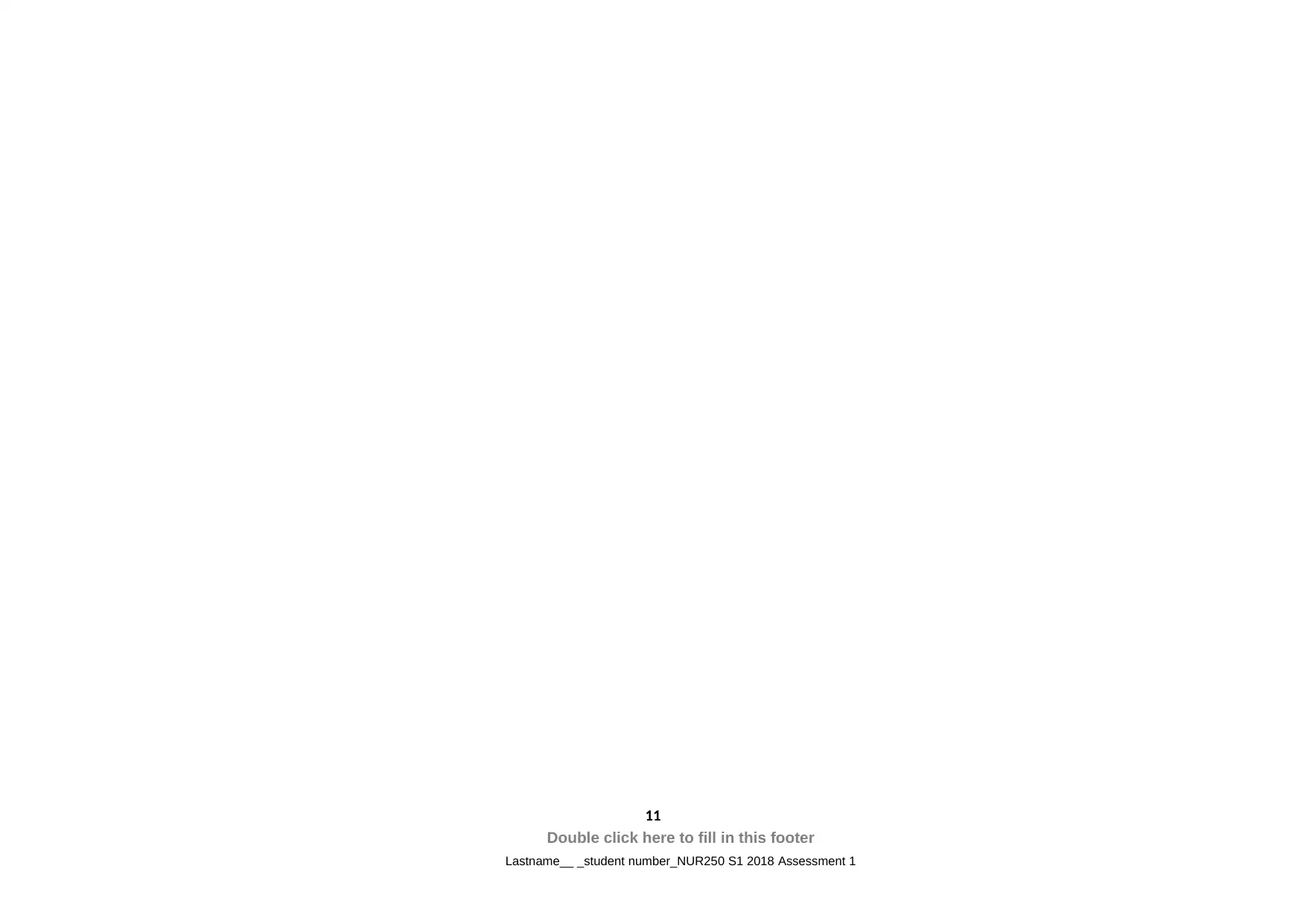
11
Double click here to fill in this footer
Lastname__ _student number_NUR250 S1 2018 Assessment 1
Double click here to fill in this footer
Lastname__ _student number_NUR250 S1 2018 Assessment 1
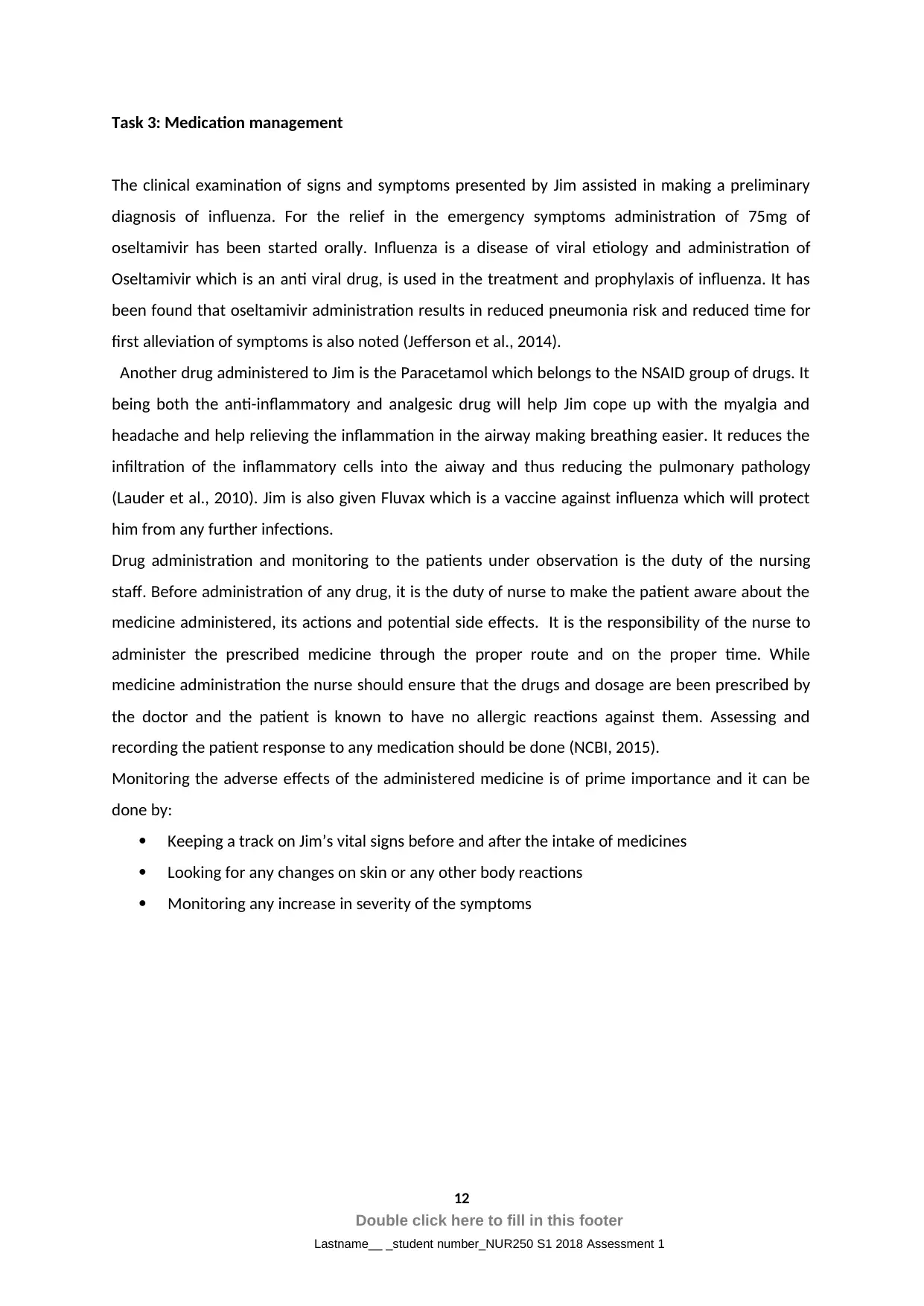
Task 3: Medication management
The clinical examination of signs and symptoms presented by Jim assisted in making a preliminary
diagnosis of influenza. For the relief in the emergency symptoms administration of 75mg of
oseltamivir has been started orally. Influenza is a disease of viral etiology and administration of
Oseltamivir which is an anti viral drug, is used in the treatment and prophylaxis of influenza. It has
been found that oseltamivir administration results in reduced pneumonia risk and reduced time for
first alleviation of symptoms is also noted (Jefferson et al., 2014).
Another drug administered to Jim is the Paracetamol which belongs to the NSAID group of drugs. It
being both the anti-inflammatory and analgesic drug will help Jim cope up with the myalgia and
headache and help relieving the inflammation in the airway making breathing easier. It reduces the
infiltration of the inflammatory cells into the aiway and thus reducing the pulmonary pathology
(Lauder et al., 2010). Jim is also given Fluvax which is a vaccine against influenza which will protect
him from any further infections.
Drug administration and monitoring to the patients under observation is the duty of the nursing
staff. Before administration of any drug, it is the duty of nurse to make the patient aware about the
medicine administered, its actions and potential side effects. It is the responsibility of the nurse to
administer the prescribed medicine through the proper route and on the proper time. While
medicine administration the nurse should ensure that the drugs and dosage are been prescribed by
the doctor and the patient is known to have no allergic reactions against them. Assessing and
recording the patient response to any medication should be done (NCBI, 2015).
Monitoring the adverse effects of the administered medicine is of prime importance and it can be
done by:
Keeping a track on Jim’s vital signs before and after the intake of medicines
Looking for any changes on skin or any other body reactions
Monitoring any increase in severity of the symptoms
12
Double click here to fill in this footer
Lastname__ _student number_NUR250 S1 2018 Assessment 1
The clinical examination of signs and symptoms presented by Jim assisted in making a preliminary
diagnosis of influenza. For the relief in the emergency symptoms administration of 75mg of
oseltamivir has been started orally. Influenza is a disease of viral etiology and administration of
Oseltamivir which is an anti viral drug, is used in the treatment and prophylaxis of influenza. It has
been found that oseltamivir administration results in reduced pneumonia risk and reduced time for
first alleviation of symptoms is also noted (Jefferson et al., 2014).
Another drug administered to Jim is the Paracetamol which belongs to the NSAID group of drugs. It
being both the anti-inflammatory and analgesic drug will help Jim cope up with the myalgia and
headache and help relieving the inflammation in the airway making breathing easier. It reduces the
infiltration of the inflammatory cells into the aiway and thus reducing the pulmonary pathology
(Lauder et al., 2010). Jim is also given Fluvax which is a vaccine against influenza which will protect
him from any further infections.
Drug administration and monitoring to the patients under observation is the duty of the nursing
staff. Before administration of any drug, it is the duty of nurse to make the patient aware about the
medicine administered, its actions and potential side effects. It is the responsibility of the nurse to
administer the prescribed medicine through the proper route and on the proper time. While
medicine administration the nurse should ensure that the drugs and dosage are been prescribed by
the doctor and the patient is known to have no allergic reactions against them. Assessing and
recording the patient response to any medication should be done (NCBI, 2015).
Monitoring the adverse effects of the administered medicine is of prime importance and it can be
done by:
Keeping a track on Jim’s vital signs before and after the intake of medicines
Looking for any changes on skin or any other body reactions
Monitoring any increase in severity of the symptoms
12
Double click here to fill in this footer
Lastname__ _student number_NUR250 S1 2018 Assessment 1
⊘ This is a preview!⊘
Do you want full access?
Subscribe today to unlock all pages.

Trusted by 1+ million students worldwide
1 out of 17
Related Documents
Your All-in-One AI-Powered Toolkit for Academic Success.
+13062052269
info@desklib.com
Available 24*7 on WhatsApp / Email
![[object Object]](/_next/static/media/star-bottom.7253800d.svg)
Unlock your academic potential
Copyright © 2020–2025 A2Z Services. All Rights Reserved. Developed and managed by ZUCOL.

